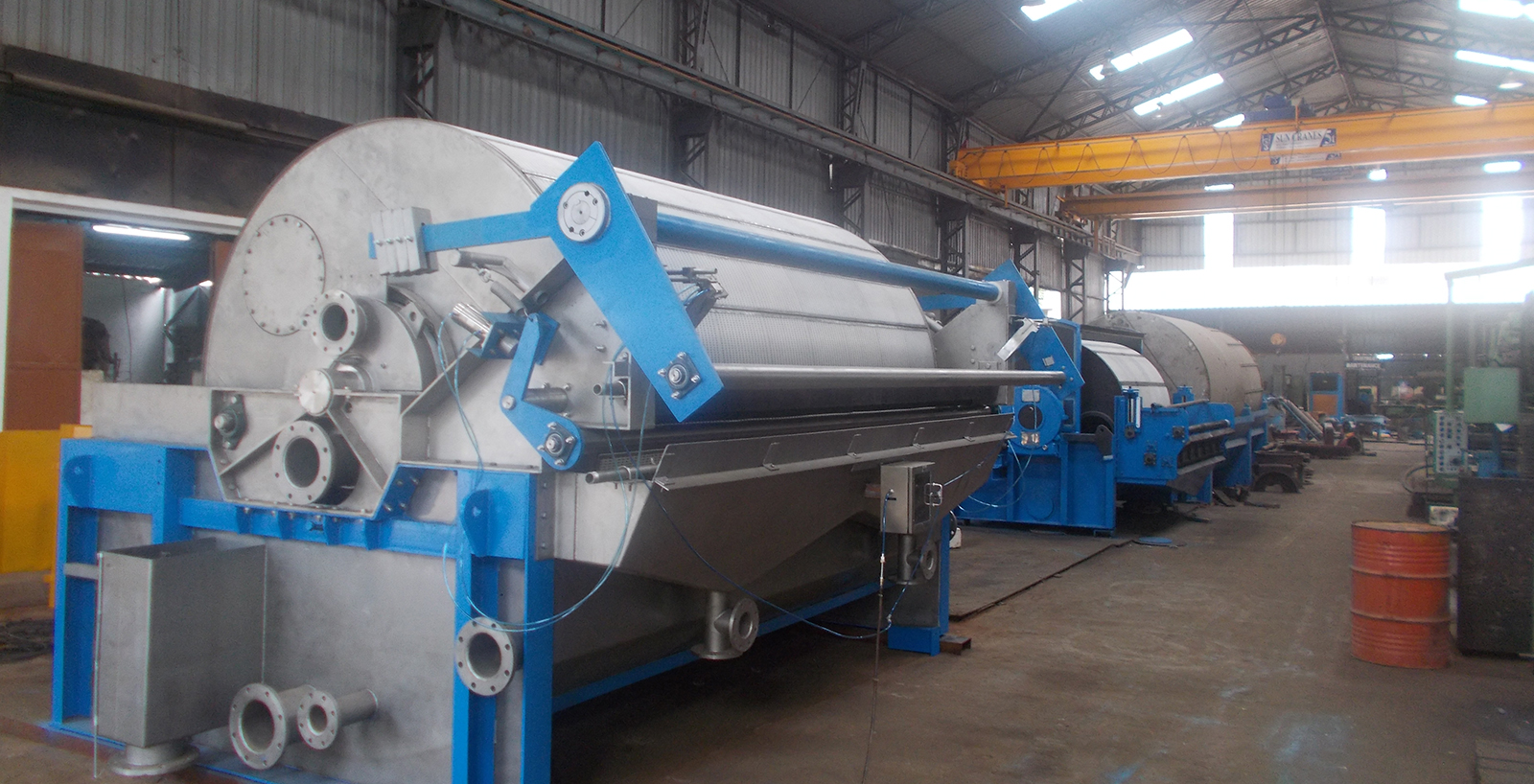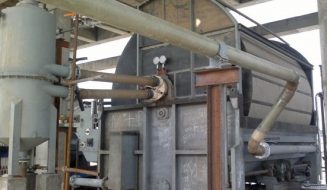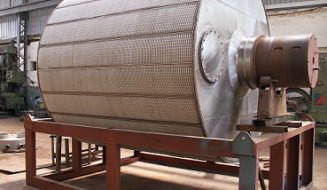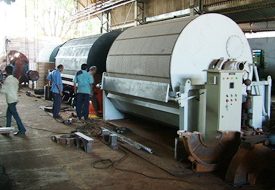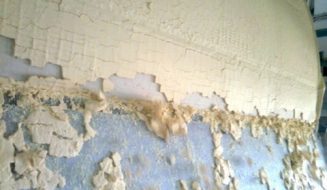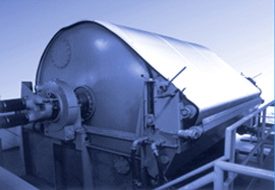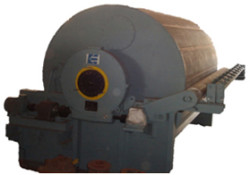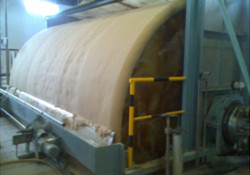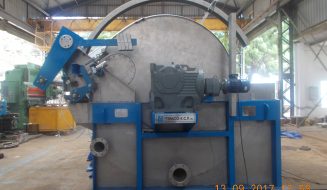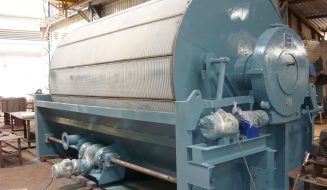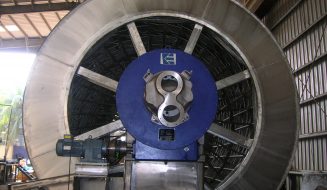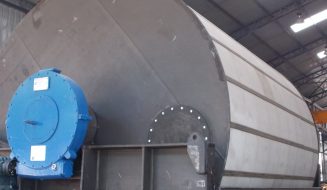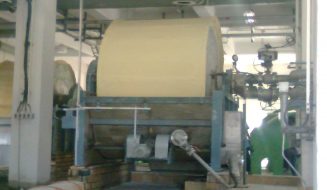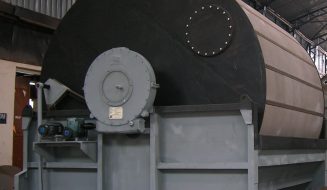Rotary Vacuum Drum Filters
EIMCO-K.C.P. Continuous vacuum drum filters are designed to handle the broadest range of slurries of any filter. This permit drum filters to be used in a variety of applications.
Vacuum filters allow a more complete separation of solids from liquids than other mechanical dewatering filters. Vacuum filters are not as dependent on specific gravity differentials for the degree of clarity, nor are they subject to upset due to variation in the process.
EIMCO-K.C.P drum filters provide high filtration rates and have excellent washing characteristics. Wide variations are possible in cycle time to ensure optimum cake formation, dewatering and washing on any application flow sheet. EIMCO-K.C.P. drum filters are ideally suited for filtering solids when cake washing is necessary when a uniform deposit of cake on the media is desired, or when the cake is difficult to discharge.
The five basic discharge types are:
SCRAPER DISCHARGE
The EIMCO-K.C.P. Scraper discharge RVDF medium is usually caulked into grooves in the drum grid, with cake removal facilitated by a scraper blade just prior to the re-submergence of the drum.
The scraper serves mainly as a deflector to direct the cake, dislodged by an air blowback, into the discharge chute, since actual contact with the medium would cause rapid wear. In some cases the filter medium is held by circumferentially wound wires spaced 50 mm (2 in) apart, and a flexible scraper blade may rest lightly against the wire winding.
Excellent for heavy solids and typical slurries are easy to filter.
BELT DISCHARGE
 The EIMCO-K.C.P. Belt discharge RVDF carrying a fabric that is removed, passed over rollers, washed, and returned to the drum. A special aligning device keeps the medium wrinkle-free and in proper line during its travel.
The EIMCO-K.C.P. Belt discharge RVDF carrying a fabric that is removed, passed over rollers, washed, and returned to the drum. A special aligning device keeps the medium wrinkle-free and in proper line during its travel.
Thin cakes of difficult solids which may be slightly soluble are good applications. When acceptable, a sluice discharge makes cakes as thin as 1.5 to 2 mm (about gin) feasible.
STRING DISCHARGE
 The EIMCO-K.C.P. String discharge RVDF system of endless strings or wires spaced about 13 mm (0.5 in) apart pass around the filter drum but are separated tangentially from the drum at the point of cake discharge, lifting the cake off as they leave contact with the drum.
The EIMCO-K.C.P. String discharge RVDF system of endless strings or wires spaced about 13 mm (0.5 in) apart pass around the filter drum but are separated tangentially from the drum at the point of cake discharge, lifting the cake off as they leave contact with the drum.
The strings return to the drum surface guided by two rollers, the cake separating from the strings as they pass over the rollers. If it has the required body, a thinner cake (5 mm) than can be handled by drum filters is feasible, allowing more difficult materials to be filtered. This is done at the expense of greater dead area on the drum. Success depends on the ability of the cake to be removed with the strings and must be determined experimentally.
Applications are mainly in the starch and pharmaceutical industries, with some in the metallurgical field.
ROLLER DISCHARGE
 A roll in close proximity to the drum at the point of cake discharge rotates in the opposite direction at a peripheral speed equal to or slightly faster than that of the drum.
A roll in close proximity to the drum at the point of cake discharge rotates in the opposite direction at a peripheral speed equal to or slightly faster than that of the drum.
If the cake on the drum is adequately tacky and cohesive for this discharge technique, it adheres to cake on the smaller roll and separates from the drum. A blade or taut wire removes the material from the discharge roll.
This design is especially good for thin, sticky cakes. If necessary, a slight air blow may be provided to help release the cake from the drum. Typical cake thickness is 1 to 10 mm (0.04 to 0.4 in).
PRE COAT DISCHARGE
 The Eimco KCP Pre-coat drum filters are coated with a bed of diatomaceous earth or similar material. During cycling a clear filtrate is obtained. When vacuum is applied, the liquid is drawn through the pre-coat material, and solids deposited on the pre-coat surface are removed along with a thin portion of the pre-coat by an advancing scraper blade, as the drum revolves. The blade operates independently of the drive to provide a “precision lathe: movement. Depending on the movement of the blade the drum can operate up to a week without retracting the blade to apply a new pre-coat bed.
The Eimco KCP Pre-coat drum filters are coated with a bed of diatomaceous earth or similar material. During cycling a clear filtrate is obtained. When vacuum is applied, the liquid is drawn through the pre-coat material, and solids deposited on the pre-coat surface are removed along with a thin portion of the pre-coat by an advancing scraper blade, as the drum revolves. The blade operates independently of the drive to provide a “precision lathe: movement. Depending on the movement of the blade the drum can operate up to a week without retracting the blade to apply a new pre-coat bed.
Pre-coat filters are recommended when small amounts of solids are to be removed from large volumes of liquids, for clarification or polishing of effluent, or for the filtration of material that produces sticky solids. They provide a high clarity of filtrate when the filtrate is the valuable product and the cake is to be discarded.

